Caesarea Philippi – Jesus called it: “gates of Hades”
Caesarea Philippi was a Roman city by Mount Hermon. And since Jesus visited it, it has become an important Christian pilgrimage destination.
Note: Philip the Tetrarch, Herod’s son, founded Caesarea Philippi.
Table of Contents
Map
The remains of Caesarea Philippi are part of Banias (Hermon Stream Nature Reserve). And Banias Nature Reserve is located at the Golan Heights, near Tel Dan Nature Reserve and Mount Hermon. Banias has two entrances, and on the following map, I marked them.
Directions for drivers: Link to Waze and Link to Google Maps
Directions for public transport: Link to Moovit
Interactive map of the area:
If you want to see the remains of Caesarea Philippi, then drive to the Banias Springs entrance.
Here is the map of this National Park:
Note: you can click on the map to enlarge it.
And here is a closeup map of the area:

Note: for additional information for visitors, like directions, opening hours, and entrance fee, see Banias (Hermon Stream Nature Reserve).
Meaning
Caesarea Philippi means Philip’s Caesarea. During the Roman period, Philipp II founded his capital city by Mount Hermon and Hermon Stream, naming it after Caesar and himself.
Herod’s son and heir, Philip II, established a city which he named Caesarea Philippi, in order to distinguish it from Caesarea Maritima, on the shore of the Mediterranean Sea.
Note: unless stated otherwise, all quotes were taken from the official website.
The city was renamed Paneas for its association with the god Pan. And today, we know it as Banias (a mispronunciation of Paneas in Arabic).
Note: do not confuse Caesarea Philippi, this site, and Caesarea National Park. The latter was founded by Herod the Great and located on the Middeterenian Sea’s seashore.
History
The Greek god Pan, after whom the place was named – Panyas (in Arabic: Banyas) – was ritually worshipped in the region of the nature reserve. At the front of the Banyas cave, there are remains of a temple built by King Herod in honor of the god Pan.
Close to the Banyas spring, a broad staircase rises to the Banyas cave. Five niches carved out of the cliff next to the cave are the remains of a shrine built by the Greeks in the 2nd century BC in honor of the god. The Greek god Pan – half man and half goat – was the god of rural areas, shepherds, and their flocks. He lived in caves, where his rituals took place, and he was known to play a reed flute.
At the front of the cave are the remains of the impressive white marble temple built here by King Herod. Herod’s son and heir, Philip II, established a city that he named Caesarea Philippi to distinguish it from Caesarea Maritima, on the shore of the Mediterranean Sea. In his time, the city flourished and gained an important status – coins were minted there, temples, bath-houses, theaters, and other public buildings were built.
In the Byzantine and Muslim periods, the city declined in status. No findings have been found of these periods.
In the period of the Crusades, a fortress was built at Banyas, the remains of which were found at archaeological digs. In this period, Banyas passed several times between the Crusaders and the Muslims until Nur-a-Din conquered it in 1164.
A Mamluk village was built on the ruins of the Crusader castle. The rural settlement of Banyas continued to exist until the 20th century. It was abandoned in the Six-Day War.
One of the most significant events of Christianity took place at Banyas: this is where Petros Simon received from Jesus the keys to the Kingdom of Heaven, which are the symbol of the Vatican (Matthew XVII, 13-20), and that is why the Banyas is a place of pilgrimage for Christians from all over the world.
Why did Jesus go to Caesarea Philippi?
Caesarea Philippi was a pagan city. They believed in false gods, and that grotto of the god Pan was the entrance to Hades – the underworld. And at this spot, Jesus says: “I will build my church, and the gates of Hades will not overcome it.”
Caesarea Philippi in the Bible
Caesarea Philippi became an important Christian pilgrimage destination as the place where Jesus asked the disciples, “Who do you say I am?”. This episode is known as Confession of Peter.
Mark 8:27-29 (New International Version):
27 Jesus and his disciples went on to the villages around Caesarea Philippi. On the way, he asked them, “Who do people say I am?”
28 They replied, “Some say John the Baptist; others say Elijah; and still others, one of the prophets.”
29 “But what about you?” he asked. “Who do you say I am?”
Peter answered, “You are the Messiah.”
Luke 9:18-20 (New International Version):
18 Once when Jesus was praying in private and his disciples were with him, he asked them, “Who do the crowds say I am?”
19 They replied, “Some say John the Baptist; others say Elijah; and still others, that one of the prophets of long ago has come back to life.”
20 “But what about you?” he asked. “Who do you say I am?”
Peter answered, “God’s Messiah.”
Matthew 16:13-19 (New International Version):
13 When Jesus came to the region of Caesarea Philippi, he asked his disciples, “Who do people say the Son of Man is?”
14 They replied, “Some say John the Baptist; others say Elijah; and still others, Jeremiah or one of the prophets.”
15 “But what about you?” he asked. “Who do you say I am?”
16 Simon Peter answered, “You are the Messiah, the Son of the living God.”
17 Jesus replied, “Blessed are you, Simon son of Jonah, for this was not revealed to you by flesh and blood, but by my Father in heaven. 18 And I tell you that you are Peter,[a] and on this rock I will build my church, and the gates of Hades[b] will not overcome it. 19 I will give you the keys of the kingdom of heaven; whatever you bind on earth will be[c] bound in heaven, and whatever you loose on earth will be[d] loosed in heaven.”Footnotes:
a. Matthew 16:18 The Greek word for Peter means rock.
b. Matthew 16:18 That is, the realm of the dead
c. Matthew 16:19 Or will have been
d. Matthew 16:19 Or will have been
As you can see, according to the gospels, in Caesarea Philippi, Peter declared that Jesus was the Messiah. But this is not the only thing that happened. In response, Jesus renamed Simon to Peter. Peter, the Greek word for rock, is the rock upon which the church will be built. He put Peter in charge and gave him the keys to heaven. Moreover, the gates of Hades, the pagan beliefs, will not win.
Also, the Transfiguration of Christ happened “in a high place nearby.” But we do not know whether it was on Mount Hermon or elsewhere.
Banias Springs
And now, let’s visit Banias (Hermon Stream Nature Reserve). As I mentioned above, you should park by the Banias Springs entrance.
When you enter the Banias Springs area, you will see the springs and the cliffs.

We will follow the trail to points of interest #3 (on the map of this national park) – The Temple of Pan.
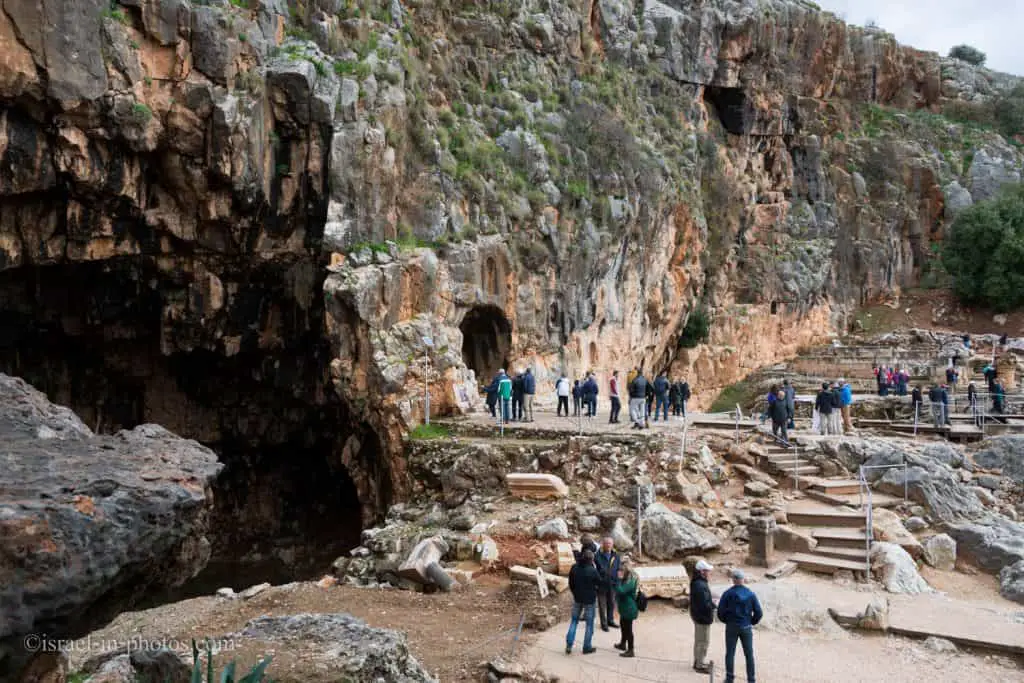
The Sanctuary of Pan
The conquests of Alexander the Great (3rd c. BCE) brought the Greeks to the East and to Banyas. The Greeks were taken by the site’s natural beauty, touched particularly by the cave in which the springs welled. It is no wonder that they sanctified this cave dedicating it to Pan, god of the forest, and the shepherds. Thus the name Panyas, later becoming “Banyas” in Arabic pronunciation.
Towards the end of the first century BCE, the Romans incorporated Banyas into Herod’s empire. To show his esteem. Herod built a temple near the Banyas springs and named it for the Roman emperor Augustus. Herod’s son, Philippus, established the seat of his capital here, calling the town Caesarea Philippi. However, the name Panyas caught on, and Banyas remains until today.
The sanctuary is located on an elevated terrace above the Banias springs, enclosed on three sides by cliff walls. The Pan cave was special due to the deep natural chasm in the floor, which led to groundwater. Animal sacrifices were thrown into this chasm.
During the Roman period, beginning from the first century BC, temples with statues, including the temple of Augustus and rock-carved niches and Greek inscriptions appeared. These indicated worship of other gods in addition to Pan. The sanctuary continued its pagan activity well into the age of Christianity in the Byzantine era (4th to 6th c. CE), but in time, the temples near the cave were neglected or ruined. The date and circumstances of the sanctuary’s destruction are not known.
The archaeological excavations conducted here by the Israel Antiquities Authority, under the direction of Dr. Zvi Uri Ma’oz, exposed the remains of temples and cult courts, sculptures, altars, and inscriptions. These findings indicate the performance of sacrificial rites and the bringing of offerings – mostly food, ceramic and other vessels, altars, and statuettes – to Pan and the Nymphs, as well to other Greek gods such as Zeus, Asclepius, Athena, Hera, Artemis, Dionysus, and Aris.
At the eastern end of the sanctuary, near the “Sacred Forest”, structures associated with a unique cult of dancing goats were exposed. One was their place of an exhibition. The other was their burial site. According to Panias city coins, at the foot of the sanctuary, there was a sacred pool of semicircular shape surrounded by a colonnade, where spring water collected. The pool served as a congregation place for worshipers and the location for the annual Pan festival. The integration of sacred architecture in the scenery of springs, mountains, forests, and a natural cave found here is unique in the Near East and perhaps in the entire Greco-Roman world.
Source: sign
At the bottom of the photo above, you can see where the Temple of Pan once stood. And here is a picture of the proposed reconstruction of this place.

Here are several additional photos from this area:
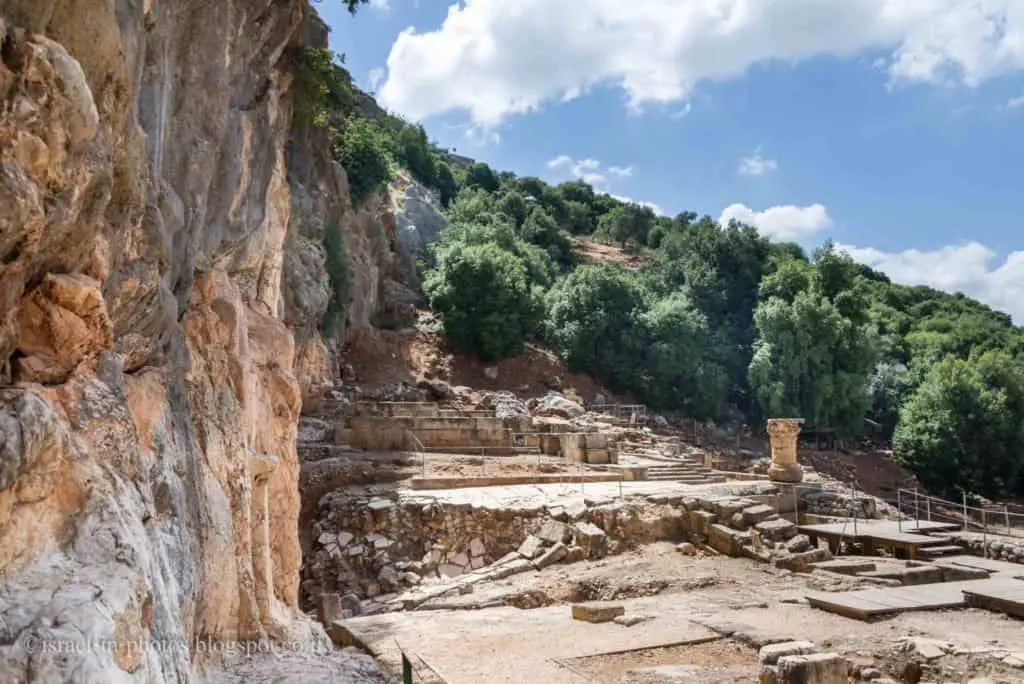

There are signs in this area with information about each building. Here is one of them.
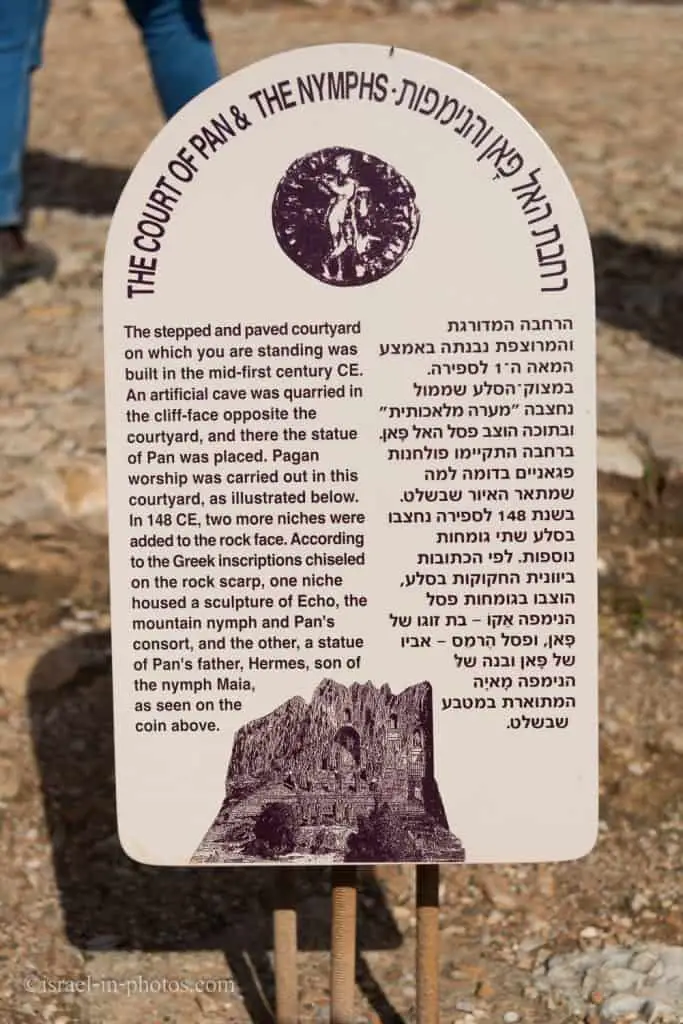
And here is the view of this area from the other side:

At the Banias Spring, we will take the purple trail that, towards the end, will lead us to the Palace Of Agrippa II.
Who was Herod Agrippa II?
Herod Agrippa II was the grand-grandson of Herod the Great.
Herod Agrippa II (AD 27/28 – c. 92 or 100), officially named Marcus Julius Agrippa and sometimes shortened to Agrippa, was the eighth and last ruler from the Herodian dynasty. He was the fifth member of this dynasty to bear the title of king, but he reigned over territories outside of Judea only as a Roman client. Agrippa was overthrown by his Jewish subjects in 66 and supported the Roman side in the First Jewish–Roman War.
Source: Wikipedia
Palace Of Agrippa II
During the second half of the first century CE, Agrippa II expanded the city limits and enhanced it with beautiful statues and magnificent buildings (according to the descriptions of Josephus Flavius). In front of you is one of these buildings, which served as a palace and seat of government. You can see a row of vaults used as warehouses, internal courtyards, a large rectangular hall (basilica), which was probably the throne room, and other rooms and halls. A winding system of passageways and water-carrier was built beneath the building.
Source: sign
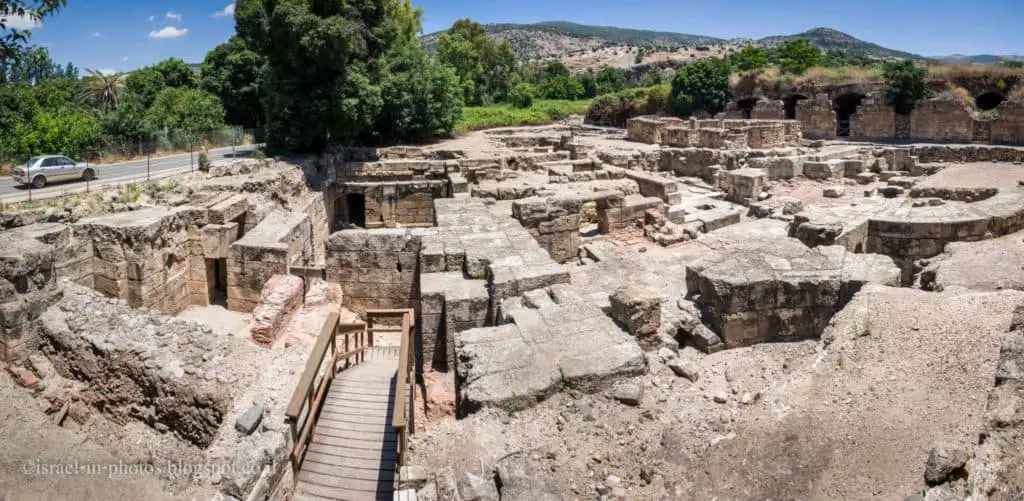
A public building that was built at the beginning of the first century BC was also uncovered at the archaeological site. The building covered more than 2,000 sq.m. and was one of the largest and most magnificent in Israel. Researchers believe that it was the palace of Agrippas II.

Looking at the photo above, you can see Nimrod Fortress on top of the right mountain.
And here is the suggested reconstruction of the palace:

Inside the Palace Of Agrippa II, you can find the remains of an old Synagogue.
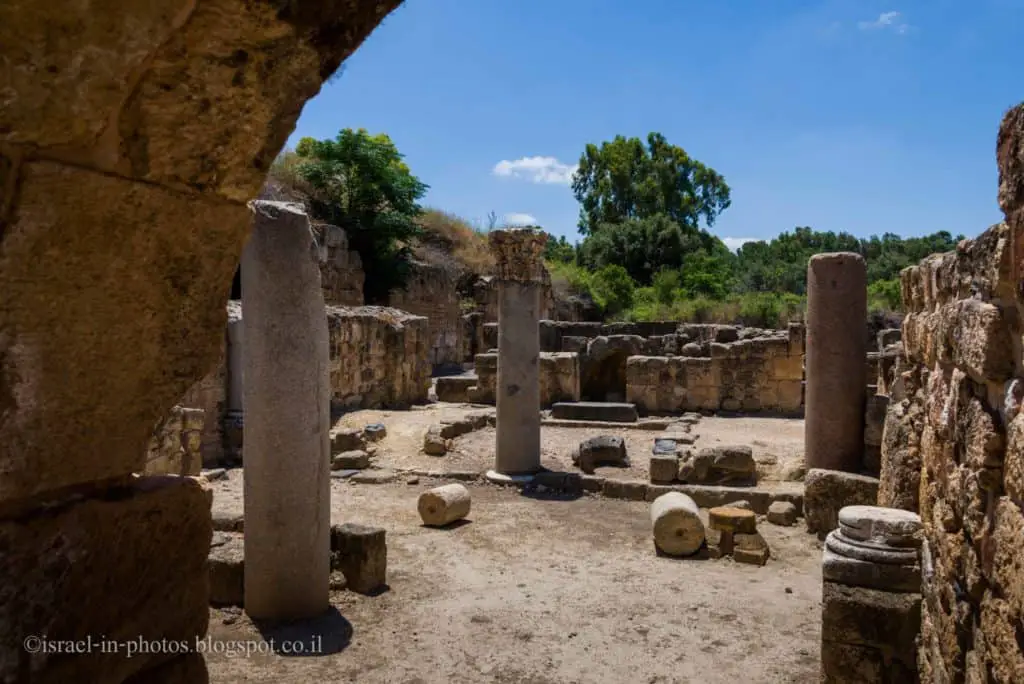
And here is how it looks from the other side:
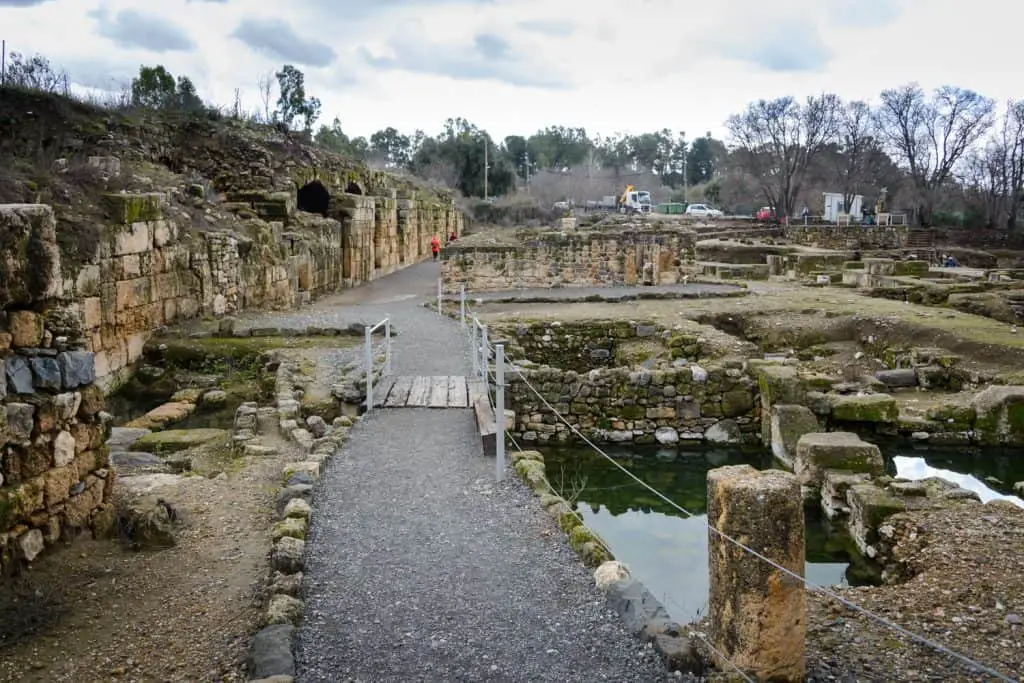
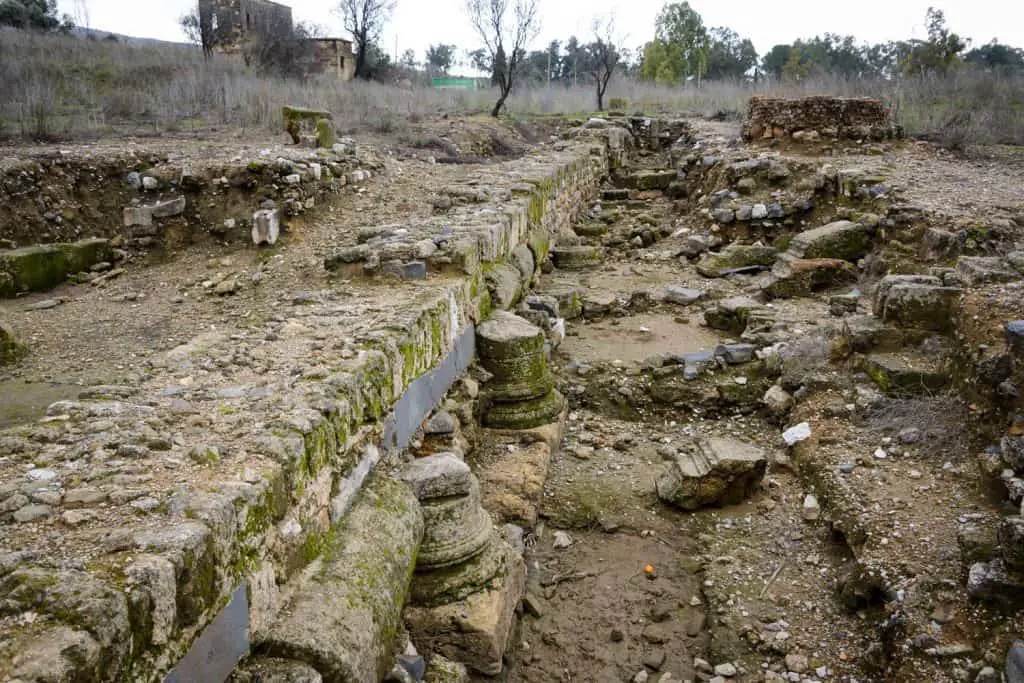
The purple trail will lead you back to the Banias Springs, and just as you pass the entry gate, you will see excavation area B to your left.
Byzantine Church
In excavation area B (#17 on the map), you can see the remains of a Byzantine church.
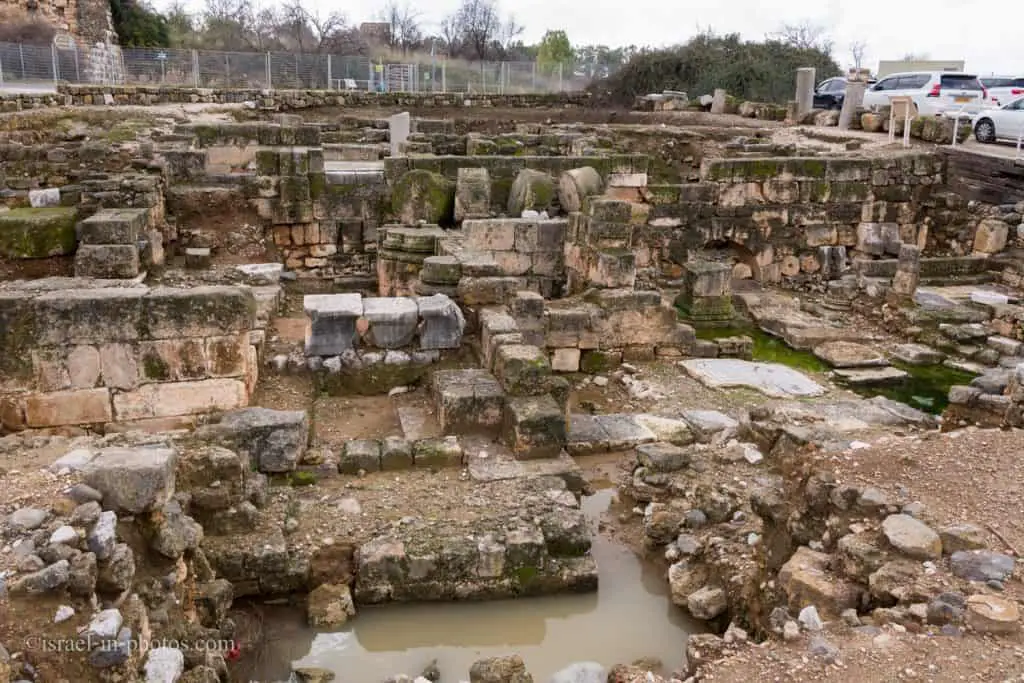
The basilica-shaped church served as the cathedral of the city of Panias during the Byzantine period (4th to 6th centuries CE). In one of the church rooms, there was a statue of Jesus depicting the “Miracle of the Bleeding Woman.” According to Christian tradition, the woman, citizen of Panias, touched Jesus’ garment and was instantly healed of all her ailments (Mark 5, 25-34; Luke 8, 43-49). The story of the statue was first appeared in writing by Bishop Eusebius, who visited the city in the 4th century CE and saw the statue with his own eyes. The church that was erected during the Byzantine period was abandoned and destroyed during the 9th century CE, following the Arab conquest.
Source: sign
And this is how it looked with the “Miracle of the Bleeding Woman” relief.

It is the end of our visit to Caesarea Philippi, but Banias has more things to offer. For additional information, see Banias (Hermon Stream Nature Reserve).
Is Caesarea and Caesarea Philippi the same place?
Caesarea Philippi and Caesarea are two different places. You can find the remains of both cities in Israel, one in the Sharon area and the other in the Golan Heights.
Summary
Banias – Hermon Stream Nature Reserve is among Israel’s most beloved nature reserves. And Caesarea Philippi is one of the reasons. Moreover, this area has many additional attractions, and you can explore them using the interactive map above.
Have you ever visited Caesarea Philippi? Tell us about your experience in the comments below.
That’s all for today, and I’ll see you in future travels!
Stay tuned!
Additional Resources
Here are several resources that I created to help travelers:- Trip Planner with Attractions and Itineraries is the page that will help you create your perfect travel route.
- What is the Best Time to visit Israel? To answer this question, we will consider the weather, prices, holidays, festivals, and more.
- Information and Tips for Tourists to Israel will answer the most common questions tourists have about Israel (including safety, passports, weather, currency, tipping, electricity, and much more).
- Israel National Parks and Nature Reserves include a complete list, top ten, map, tickets (Israel Pass, Matmon, combo), and campsites.
- If you are looking for things to do, here are the pages for Jerusalem, Tel Aviv, Haifa, Sea Of Galilee, Akko (Acre), Eilat, Nazareth, Safed (Tzfat), and Makhtesh Ramon.

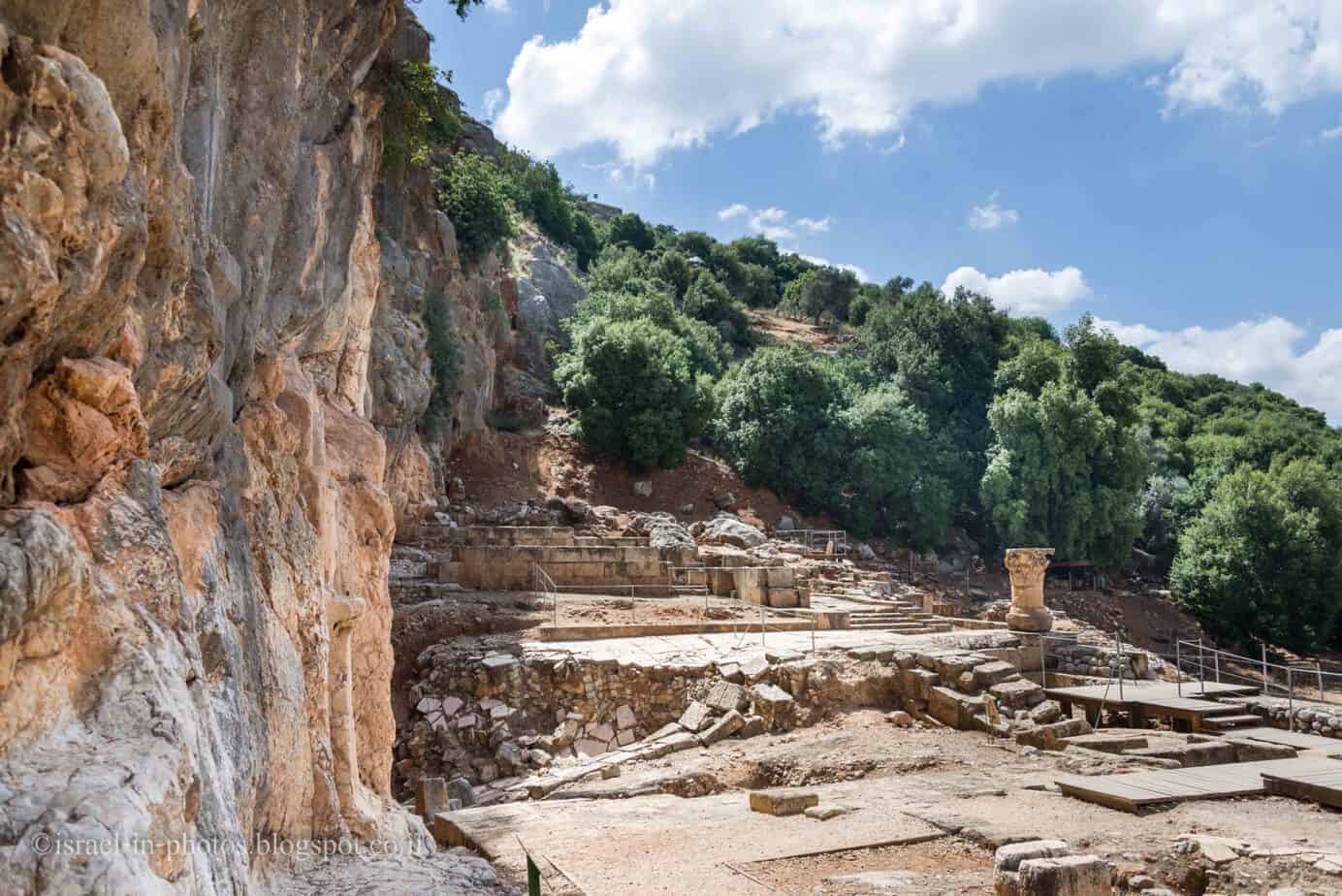







I have never been to the site but from extensive photographic views I have examined I wish to point out several discrepancies: the “Cave of Pan” was NEVER the source of the springs of the Jordan River! THIS was a MYTH actually begun by the ancient Roman Judish priest-historian Flavius Josephus. I have SEEN photos of the Cave when it is COMPLETELY DRY and the exposed ground is SOLID dirt and rocks!! There is NO “abyss” within it and COULDN’T be, because there is a LARGE, table-sized projection of ROCK practically in the center of the Cave! Apparently, SOME people are interested in perpetuating the MYTH about the Cave and doing photo-ops TRICKS in their photographs made when the Cave is full of groundwater, to HIDE the Rock so that it does NOT appear; thereby giving the ILLUSION that the water is part of a deep “pool”.
There also ISN’T any architectural remains of Greco-Roman temples on the cliffside platform. There are a few incense altars, but THAT’S it. There are also a few stumps of columns, indicating the platform was the site of the “Colonnade”; which thus, would NOT have been semi-circular, as frequently described. From what I have read about the MULTI-level platform, it was not only the “dancing floor” of “Pan’s dancing goats” but also supported a structure containing the tomb chambers for the mummified remains of the “sacred goats”! The largest platform area was the lowest and in front of the large, artificial grotto next to the natural Cave. In the grotto at the back of it was carved a small niche. Though the grotto was large enough to contain a full life-sized statue of Pan, it apparently did not; since THAT would have obscured the statuette placed in the niche at the back. Since there was an inscribed statuette niche above the grotto and one of THREE that would have held statuette’s of each of the three kinds of “pagan nymphs”: Oreads (of the mountains), Dryads (of the trees), and Hyades (of the springs and rivers), the grotto niche itself probably held a statuette of Venus, the FAVORITE of Pan and the patroness of the Nymphs. Though the site needs to be FULLY excavated, it seems that the large, square platform in the center of the settlement was actually the site for the multiple temples of Pan, Venus, Zeus, and Caesar Augustus.
I am doing more study of the area and would appreciate if you would send me any field archaeology photographs (both ground and aerial) made at the time of the past excavations for a fuller study of the area. I am particularly interested in the earliest views WITHOUT all the vegetation covering the source of the waterfall leading from the cliffside to the river as being the source of the Jordan. So far I have not been able to find any online. Thank you.
Hi Richard,
As far as I remember, at least in one of my visits I saw water in the cave of Pan. It was not deep (about 5-10 cm), but there was water.
In my post about Banias (https://www.israel-in-photos.com/banias.html), you can see “Artists impression of the Sanctuary of Pan”. That is the best I know.
Unfortunately, my searches did not yield any meaningful results.
This national park is managed by Israel National Parks Authority. And any excavation done, will be done either by them or with their cooperation.
At the official page (https://en.parks.org.il//reserve-park/hermon-stream-banias-nature-reserve/) there is no email, but you can contact them at their Facebook page or Instagram page.
You can also contact Israel Antiquities Authority at https://www.iaa.org.il/en/page/contact-us
Good Luck!